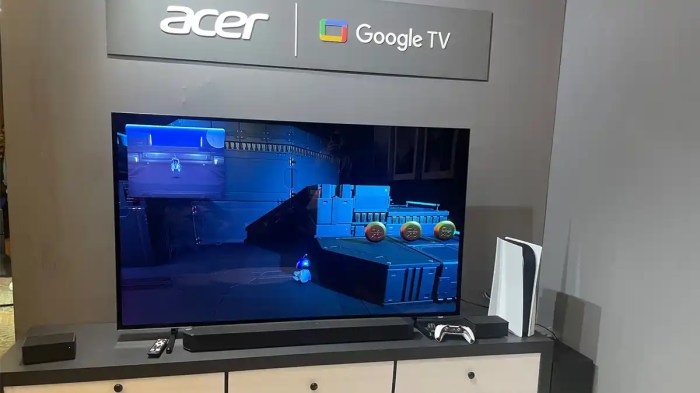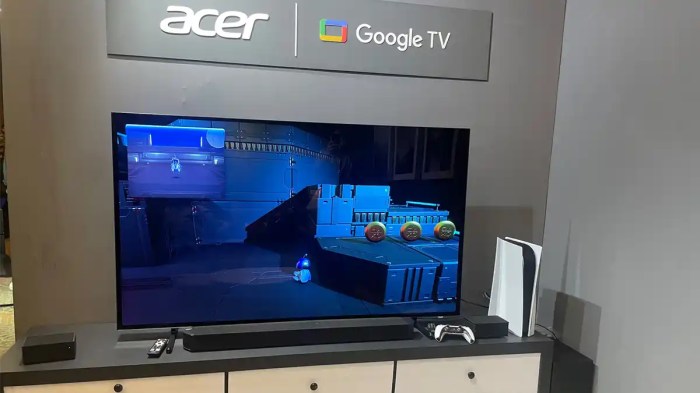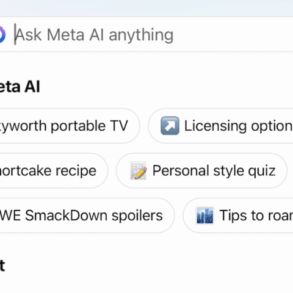Google adds individual user profiles to Google TVs, promising a more personalized viewing experience. This integration could revolutionize how we interact with smart TVs, offering tailored content recommendations and ads. However, it also raises important questions about privacy and how this data will be used.
The integration of user profiles into Google TVs opens up a world of possibilities for personalized content experiences. Imagine having a dedicated space for each family member, filled with movies and shows they’ll love. This personalization could extend to targeted advertising, potentially leading to more relevant ads on the TV screen.
User Profile Integration Impact
Google’s integration of user profiles into Google TV devices promises a personalized viewing experience. This feature, if executed effectively, could significantly enhance the user journey by tailoring recommendations and content offerings to individual preferences. However, the potential impact on user experience, privacy, and Google’s competitive standing requires careful consideration.The integration of user profiles into Google TV is analogous to similar features found in other streaming platforms, like Netflix and Hulu.
These platforms already leverage user viewing history to curate personalized recommendations. Google TV, by adopting this approach, aims to deliver a comparable level of tailored content discovery. However, the key differentiator lies in Google’s broader ecosystem, potentially enabling a more seamless integration across its various products and services.
Potential Effects on User Experience
This integration has the potential to revolutionize the user experience by creating a truly personalized entertainment hub. Users can expect tailored recommendations based on their viewing habits, enabling them to quickly discover content they’ll enjoy. Moreover, seamless profile switching and content synchronization across devices will become a reality, further enhancing user convenience.
Comparison with Similar Services
Existing streaming services like Netflix and Hulu already leverage user data to provide personalized recommendations. Netflix, for instance, analyzes viewing history, ratings, and even search queries to suggest movies and shows. Google TV, with its integrated user profile feature, aims to emulate this personalized experience. A key difference lies in the potential for broader ecosystem integration, allowing users to link their Google accounts and preferences across various Google services.
This could offer a more comprehensive and unified user experience.
Privacy Implications
The integration of user profiles into Google TV raises important privacy concerns. Users must trust Google with their viewing data, understanding that this information will be used to tailor recommendations. The potential for data breaches or misuse necessitates robust security measures. Google should clearly articulate its data handling policies and offer users granular control over their data, including the ability to opt-out of certain data collection or modify their profile information.
Transparency in data usage is crucial to maintain user trust.
Competitive Advantages for Google
This feature has the potential to provide Google with a significant competitive edge. By offering a more personalized and user-friendly experience, Google TV can attract and retain users. The integration of user profiles could also enhance the overall appeal of Google TV, positioning it as a more sophisticated and attractive alternative to existing platforms. Furthermore, the ability to seamlessly integrate with other Google services will likely strengthen user loyalty.
Potential User Reactions
| Potential User Reaction | Positive Aspects | Negative Aspects |
|---|---|---|
| Positive | Personalized recommendations, enhanced user experience, seamless profile switching, increased convenience | Concerns about data privacy, potential for data misuse, lack of control over data collection |
| Negative | Privacy concerns, fear of data misuse, lack of control over data collection, potential for intrusive recommendations | Limited personalization options, difficulty in managing multiple profiles, technical glitches |
Advertising and Targeting Strategies

The integration of individual user profiles into Google TVs marks a significant shift in how advertising is delivered. This granular level of user data empowers Google to tailor ads with unprecedented precision, moving beyond broad demographic targeting to a highly personalized experience. This evolution promises both exciting opportunities and potentially complex challenges regarding privacy and user control.The integration of user profiles unlocks a new era of personalized advertising on Google TVs.
By leveraging detailed information about individual viewing habits, preferences, and demographics, Google can curate more relevant and engaging advertisements. This shift from generic campaigns to hyper-personalized experiences is expected to increase user engagement and ad effectiveness.
Google adding individual user profiles to Google TVs is a fascinating development, but it also raises some security concerns. Think about how this new feature opens up a whole new avenue for potential vulnerabilities. This is where legacy antivirus solutions become a prime target, as they often struggle to keep up with the evolving threat landscape, as detailed in this article about why legacy antivirus is an easy target.
This increased digital footprint, combined with the complexity of modern attacks, makes robust security measures crucial, especially for connected devices like smart TVs.
Personalized Ad Examples
Google could deliver ads based on specific shows a user has watched, or even the products featured in those shows. For instance, if a user frequently watches cooking shows featuring a particular brand of kitchen appliances, ads for those appliances might appear during or shortly after the show. Similarly, if a user consistently views content related to travel, ads for travel agencies, hotels, and related services could be strategically placed.
Further, ads could be dynamically adjusted based on the time of day or the specific content being viewed.
Potential New Revenue Streams
This integration could lead to increased ad revenue for Google. With more precise targeting, advertisers can expect a higher return on investment (ROI). This, in turn, encourages greater investment in Google TV advertising, potentially driving a surge in revenue. Additionally, Google could introduce new ad formats tailored for the interactive and visual nature of the Google TV platform.
Implications for Ad Blockers and Privacy Settings
The integration of user profiles presents a significant challenge for ad blockers. Ad blockers may need to be updated to handle the sophisticated personalization strategies. Conversely, users will have greater control over their privacy settings. Google will need to provide clear and comprehensive options for users to manage their data and tailor their ad experience. This necessitates transparent communication about how user data is collected, used, and protected.
Targeting Options, Google adds individual user profiles to google tvs
| Targeting Category | Description | Example |
|---|---|---|
| Viewing History | Ads based on previously watched shows, movies, or genres. | If a user frequently watches documentaries, ads for educational resources might appear. |
| Device Location | Ads based on the user’s geographical location, potentially even down to the city level. | A user in New York City might see ads for local restaurants or attractions. |
| Search History | Ads based on past searches on Google or other Google services. | If a user searches for “best running shoes,” ads for running apparel and gear could be displayed. |
| Purchase History | Ads based on products previously purchased on Google Play or other online platforms. | A user who bought a specific brand of headphones might see ads for accessories or related products. |
| Demographic Data | Ads based on age, gender, and other demographic information (if provided). | Ads for specific age groups or interests. |
This table Artikels various targeting options. The table demonstrates the potential for Google to deliver highly specific ads based on user behavior and preferences. This detailed targeting is a potential key to increased effectiveness for advertisers.
Technical Implementation Considerations
Integrating user profiles from Google Ads into Google TVs necessitates a robust technical framework. This involves careful planning of data synchronization methods, stringent security protocols, and consideration for potential compatibility issues across diverse devices and operating systems. Successful implementation hinges on meticulous attention to detail at each stage.
Data Synchronization Methods
Different methods for synchronizing user profile data from Google Ads to Google TVs each have unique strengths and weaknesses. A crucial aspect is choosing a method that balances speed, reliability, and security. Direct API calls offer real-time updates, while batch processing is more suitable for large datasets and can be more cost-effective. A hybrid approach combining these techniques might be ideal for optimal performance.
- Direct API Calls: This approach involves direct communication between the Google Ads and Google TV platforms using Application Programming Interfaces (APIs). Real-time updates are possible, enabling immediate reflection of changes in the user’s advertising profile on the TV. However, this requires careful management of API requests and potential network latency issues.
- Batch Processing: This method involves periodic transfer of user profile data in batches. While slower than real-time updates, batch processing is more suitable for large datasets, minimizing API call frequency and potentially reducing costs. Data consistency can be ensured by implementing a robust batching mechanism. Examples include scheduled nightly updates or weekly data imports.
- Hybrid Approach: A combination of direct API calls for critical data updates and batch processing for less time-sensitive information can offer the best balance. This method allows for real-time adjustments while managing large datasets efficiently.
Security Measures
Protecting user data during integration is paramount. Robust encryption and access control mechanisms are essential. Data should be encrypted both in transit and at rest. Implementing multi-factor authentication (MFA) for API access is critical to preventing unauthorized access. Regular security audits are also needed to ensure ongoing protection.
- Data Encryption: Data should be encrypted using industry-standard encryption algorithms (e.g., AES-256) both during transmission (in transit) and storage (at rest). This safeguards sensitive user information.
- Access Control: Implementing granular access control measures, limiting access to authorized personnel, is vital. This involves using robust authentication mechanisms, like multi-factor authentication (MFA). Access should be limited to only those personnel needing it.
- Regular Security Audits: Periodic security audits are crucial to identify and mitigate vulnerabilities. This proactive approach helps ensure the ongoing protection of user data.
Compatibility Considerations
Integrating with various devices and operating systems requires careful testing and validation. Different Google TV models and software versions might require tailored implementations to ensure seamless integration. Testing across a range of devices and operating systems is essential. Thorough testing ensures compatibility and minimizes issues.
- Device Compatibility: Testing across different Google TV models, including various screen sizes and resolutions, is crucial to ensure consistent user experience.
- Operating System Compatibility: Ensuring compatibility with different Android versions and other potential operating systems is necessary. This includes conducting rigorous testing across different operating systems.
- Software Version Compatibility: Keeping track of software versions and updating the integration accordingly is critical. Ensuring that the integration remains compatible with future software updates is necessary.
Technical Implementation Steps
A well-defined process for data integration is essential for a smooth transition. The following table Artikels the key steps involved.
| Step | Description |
|---|---|
| 1. API Integration | Establishing secure connections between Google Ads and Google TV platforms using APIs. |
| 2. Data Mapping | Defining the structure and format for exchanging user profile data. |
| 3. Data Validation | Implementing checks to ensure data accuracy and consistency. |
| 4. Security Configuration | Implementing robust security measures, including encryption and access controls. |
| 5. Testing and Deployment | Thorough testing across different devices and operating systems before deployment. |
User Interface and Experience: Google Adds Individual User Profiles To Google Tvs
Bringing user profiles to Google TV unlocks a world of personalized experiences. This integration will transform how users interact with the platform, moving beyond simple browsing to curated recommendations and tailored advertisements. The key is to create an intuitive and engaging interface that seamlessly integrates these new features without overwhelming the user.The design choices for incorporating user profiles into Google TV must prioritize user experience.
A well-designed interface will encourage exploration and discovery while respecting user privacy and preferences. A balance must be struck between offering personalized recommendations and allowing users to easily manage their profiles and preferences.
Potential Design Choices for Profile Integration
The Google TV interface can accommodate user profiles in several ways. A dedicated profile section, accessible via a user icon, will be crucial for managing settings, preferences, and account details. This section could house profile pictures, personalized themes, and options to customize recommendations. Another key aspect is ensuring the integration doesn’t negatively impact the existing core functionalities of the platform.
User Interface Design Considerations for Personalized Content Recommendations
Effective personalization requires a thoughtful approach to content recommendation algorithms. These algorithms must be transparent and user-friendly, giving users insight into the factors influencing recommendations. Users should be able to adjust the level of personalization or even opt out entirely. This approach balances user control and the benefit of personalized experiences. Clear explanations of how recommendations are generated and the ability to customize filters or categories are essential.
Google’s recent move to add individual user profiles to Google TVs is fascinating. It’s like adding a personalized touch to a device that’s already quite intuitive. This raises questions about data collection and user experience, but also opens up possibilities for more tailored recommendations. It’s intriguing to think about how this impacts the user experience, especially when considering the broader context of planets, space, rogue stars, and telescope exploration and discoveries.
The potential for more targeted ads and personalized content is real, and how that plays out on a larger scale will be interesting to watch, just as we explore the vastness of space with ever-evolving technology.
For example, users should be able to specify genres or types of content they prefer.
Examples of User Profile Display and Access
The user profile could be prominently displayed on the home screen, perhaps with a profile picture and the user’s name. This would allow easy identification and access to personalized settings. A menu within the settings section should be readily available for managing profile details, preferences, and the level of personalization for recommendations. A quick access option for adjusting personalized recommendations might also be desirable.
Possible User Experience with Personalized Ads and Content Recommendations
Personalized ads, delivered through the platform, could enhance the user experience by providing relevant advertisements. Users might see more tailored recommendations for movies, shows, and apps that align with their preferences. This can lead to a more engaging viewing experience, as users are more likely to find content they genuinely enjoy. However, the design must prioritize user privacy and ensure that ads are not intrusive or overly targeted.
Mockups of Google TV Interface Designs with Integrated User Profiles
| Design | Description | Profile Display | Personalized Recommendations |
|---|---|---|---|
| Design A | Simple and clean design with a prominent profile icon on the home screen. A dedicated profile menu in settings. | Profile picture and name displayed on the home screen, with a direct access option for profile settings. | Personalized recommendations are presented separately, with an option to filter by profile. |
| Design B | Modern and minimalist design, with profiles integrated into the search and browsing functionalities. | Profiles integrated into the search results and recommendations, allowing easy identification of relevant content for the specific profile. | Recommendations are dynamically displayed based on profile preferences and activities. |
| Design C | Interactive design that allows users to customize their profiles through a visual interface. | Profile pictures and themes that are visually engaging and can be customized. | Recommendations are based on a wide range of data, from viewing history to profile preferences, enabling a highly personalized experience. |
Competitive Landscape Analysis
The integration of individual user profiles into Google TVs presents a compelling opportunity, but also necessitates a careful examination of the competitive landscape. Understanding how rivals approach personalization and advertising on smart TVs is crucial to anticipating their responses and maximizing Google’s own strategic advantage. This analysis will delve into key competitors, their strategies, potential reactions, and the broader market implications.The smart TV market is highly competitive, with established players like Samsung, LG, and Sony vying for market share.
Each manufacturer offers its own ecosystem of apps and services, and understanding these ecosystems is essential to analyzing the potential impact of Google’s integration. A detailed comparison will highlight how Google’s approach, focused on user profile integration and personalized advertising, differs from the strategies employed by competitors.
Key Competitors in the Smart TV Market
Several companies dominate the smart TV market, each with its own strengths and weaknesses. Samsung, LG, and Sony are prominent players, along with emerging brands offering unique features. Understanding their current strategies is paramount to evaluating Google’s competitive position.
Comparison of Google’s Approach with Competitors’ Strategies
Google’s approach to user profile integration and personalized advertising on smart TVs stands apart from competitors. While other manufacturers offer some level of personalization, Google’s strategy emphasizes a deeper understanding of user preferences, leveraging data for targeted advertising. This differs significantly from some competitors’ reliance on pre-loaded apps or basic recommendations. For example, Samsung’s Tizen operating system is known for its ecosystem of apps, but less emphasis on granular user profile data for personalized ads.
LG’s webOS platform is another example, with a focus on a streamlined user interface rather than intensive data collection for targeted advertising.
Google adding individual user profiles to Google TVs is a pretty big deal. It’s like a personalized, always-on digital assistant built into your living room. This opens up fascinating possibilities, but also raises questions about data privacy. And it got me thinking about other conversations around personal data and the media landscape. For example, the recent discussion on bill maher podcast sage seele andrew huberman lex fridman spotify ambies touched on similar themes about the future of information consumption.
Ultimately, it all circles back to how Google TVs are becoming more and more integrated into our daily lives, and how those integrations will affect the user experience.
Potential Competitor Responses to Google’s Integration
Competitors will likely respond in several ways to Google’s enhanced personalization features. Some may adopt similar strategies to enhance their own user profile integration, while others may emphasize alternative value propositions, such as superior hardware features or unique content partnerships. A likely response is to enhance their own user interfaces to offer a more seamless and intuitive user experience, and to add more features and apps.
Another strategy is to highlight their existing ecosystem of apps and content as a key differentiator. It is also possible that some competitors will adopt more privacy-focused approaches to advertising, emphasizing user control over data collection and usage.
Impact on the Overall Smart TV Market
Google’s integration is expected to significantly impact the overall smart TV market by driving innovation in personalization and advertising. The shift towards more data-driven approaches will likely encourage other manufacturers to enhance their own user experience and develop more advanced personalization features. This dynamic is expected to lead to a heightened focus on user privacy and data security, forcing competitors to be transparent and accountable for their data collection and usage practices.
Summary of Competitive Landscape and Google’s Position
| Competitor | Key Strategy | Potential Response to Google’s Integration | Google’s Position |
|---|---|---|---|
| Samsung | Extensive app ecosystem, user-friendly interface | Enhance user profile integration, potentially focus on hardware differentiation | Focus on personalized advertising, leveraging user profile data |
| LG | WebOS platform, emphasis on user interface | Improve personalization features, highlight existing content partnerships | Leveraging comprehensive user data for targeted ads |
| Sony | Strong brand reputation, high-quality hardware | Enhance personalization, potentially partner with Google for certain features | Leveraging user profiles for tailored advertising experience |
| Emerging Brands | Focus on specific niches or features | Adapt to Google’s integration, focusing on differentiation through innovative features | Opportunity to gain market share by providing competitive features |
Privacy and Security Implications

Integrating user profiles from Google Ads into Google TV presents exciting possibilities but also raises significant privacy concerns. Users need to understand how their data might be collected, used, and potentially shared, alongside the safeguards Google employs to protect it. This section explores the potential risks, Google’s proposed mitigation strategies, and the broader legal and regulatory landscape surrounding this integration.This integration raises crucial questions about user data ownership, control, and the potential for misuse.
Understanding these implications is paramount for users to make informed decisions about how they interact with the Google ecosystem.
Potential Privacy Risks
User data, including browsing history, search queries, and purchase information from Google Ads, is likely to be linked with viewing activity on Google TV. This combined data set could paint a detailed and potentially sensitive portrait of a user’s preferences, interests, and even their daily routines. The potential for targeted advertising based on this combined data set is substantial, and raises concerns about the potential for personalized and invasive advertising.
This heightened level of personalization could also inadvertently reveal sensitive information, potentially leading to discriminatory practices or privacy violations.
Measures to Address User Privacy Concerns
Google could significantly mitigate these risks by implementing robust privacy controls and data security measures. These measures should include:
- Enhanced Transparency: Providing clear and concise explanations of how user data is collected, used, and shared is crucial. Detailed privacy policies should be readily accessible and easily understandable. Users should be presented with clear and comprehensive information about how their data is utilized for advertising purposes on Google TV, and given granular control over this data.
- Granular Control: Offering users granular control over their data is essential. Users should have the ability to opt out of specific data collection practices, or to limit the data shared between Google Ads and Google TV. This includes the ability to selectively disable data sharing or customize data sharing for different Google services.
- Data Minimization: Collecting only the necessary data for the intended purpose is a crucial data security principle. Google should minimize the amount of data collected and stored, only collecting information directly relevant to the Google TV experience.
- Robust Security Measures: Employing strong encryption and secure storage protocols is critical to protect user data from unauthorized access or breaches. Regular security audits and incident response plans are essential to ensure user data remains protected.
Examples of Data Use and Misuse
A user’s shopping history on Google Ads could be linked with their viewing habits on Google TV, revealing shopping preferences or interest in certain products that may not be commonly viewed. For instance, a user who searches for “smart home devices” on Google Ads and subsequently watches a Google TV advertisement for a smart thermostat is an example of how linked data can lead to targeted advertising.
However, a malicious actor gaining access to this data could potentially exploit it for discriminatory advertising or other malicious purposes.
Legal and Regulatory Implications
Data privacy regulations, such as GDPR and CCPA, could significantly impact this integration. Google must ensure its practices comply with these regulations, including obtaining informed consent for data collection and providing users with clear opt-out options. Google must be prepared to face potential legal challenges and regulatory scrutiny if their practices do not meet the standards set by these regulations.
Failure to comply could result in significant fines and reputational damage.
Privacy Settings and Controls for Users
| Privacy Setting | Description | User Impact |
|---|---|---|
| Data Sharing Control | Allows users to selectively enable or disable data sharing between Google Ads and Google TV. | Users maintain control over how their data is combined across services. |
| Targeted Advertising Opt-out | Enables users to opt out of targeted advertising based on their Google Ads and Google TV activity. | Reduces personalized advertising based on combined data. |
| Data Deletion Options | Allows users to request deletion of their data associated with Google Ads and Google TV. | Users retain control over their data’s lifecycle and can choose to remove it from Google’s systems. |
Potential Use Cases
Integrating individual user profiles into Google TV opens a world of personalized experiences. This integration allows for a more tailored approach to recommendations, ads, and overall user engagement, ultimately leading to a more enjoyable and efficient TV viewing experience. Imagine a future where your Google TV anticipates your preferences, offering precisely what you’re looking for, and advertising products that genuinely resonate with your interests.
Personalized Recommendations
Tailored recommendations are key to enhancing user experience. By leveraging user profile data, Google TV can predict viewing patterns and offer suggestions for movies, shows, and content that align with individual tastes. This goes beyond generic genre recommendations; it delves into specific actors, directors, or even plot elements to offer more nuanced and accurate suggestions. For example, a user who enjoys action films with strong female leads could receive recommendations that precisely match these criteria, ensuring a more engaging viewing experience.
Targeted Advertising
Targeted advertising can benefit both users and advertisers. For users, relevant ads become less intrusive and more likely to be engaging. Instead of generic commercials, users are presented with advertisements for products and services that genuinely interest them. This enhances the user experience by reducing the frequency of irrelevant ads. For advertisers, targeted ads offer a higher return on investment by reaching potential customers who are more likely to be interested in their offerings.
This approach to advertising reduces wasted ad spend on audiences unlikely to convert.
Illustrative Scenarios
Numerous scenarios showcase the value of this integration. A user who frequently watches documentaries about space exploration might see advertisements for astronomy equipment or subscription services offering similar content. A family with children interested in educational programming could receive targeted recommendations and ads for educational apps or toys. Furthermore, a user who often cooks might see ads for new recipes, kitchen appliances, or cooking classes.
This personalized approach fosters a more valuable and productive relationship between users and advertisers.
Impact on User Engagement
User engagement is directly influenced by personalized experiences. When recommendations precisely match user interests, users are more likely to explore new content, spend more time interacting with the platform, and ultimately have a more positive experience. This increased engagement can lead to higher retention rates and increased user satisfaction. A positive user experience directly correlates with the user’s perceived value from the service.
User Scenarios and Impact
| User Scenario | Impact of Profile Integration |
|---|---|
| User frequently watches documentaries about nature. | Receives recommendations for documentaries about nature, outdoor activities, and nature-related products. Targeted ads for documentaries, nature magazines, and outdoor gear appear. |
| User enjoys watching movies from the 1980s. | Receives recommendations for 1980s movies, actors, and directors. Targeted ads for classic movies, 80s memorabilia, or nostalgic products appear. |
| User has young children and enjoys educational content. | Receives recommendations for educational programs, children’s shows, and educational apps. Targeted ads for educational toys, books, and learning materials appear. |
| User is a frequent cook. | Receives recommendations for cooking shows, recipes, and cooking-related products. Targeted ads for cooking appliances, ingredients, and recipe books appear. |
Closure
Google’s move to integrate individual user profiles into Google TVs is a significant step toward a more personalized entertainment experience. While it promises benefits like tailored recommendations and ads, privacy concerns are undeniable. The competitive landscape will be affected, and how users react will shape the future of smart TVs. The future of user interaction with smart TVs looks bright, with potential for great improvements in experience.












